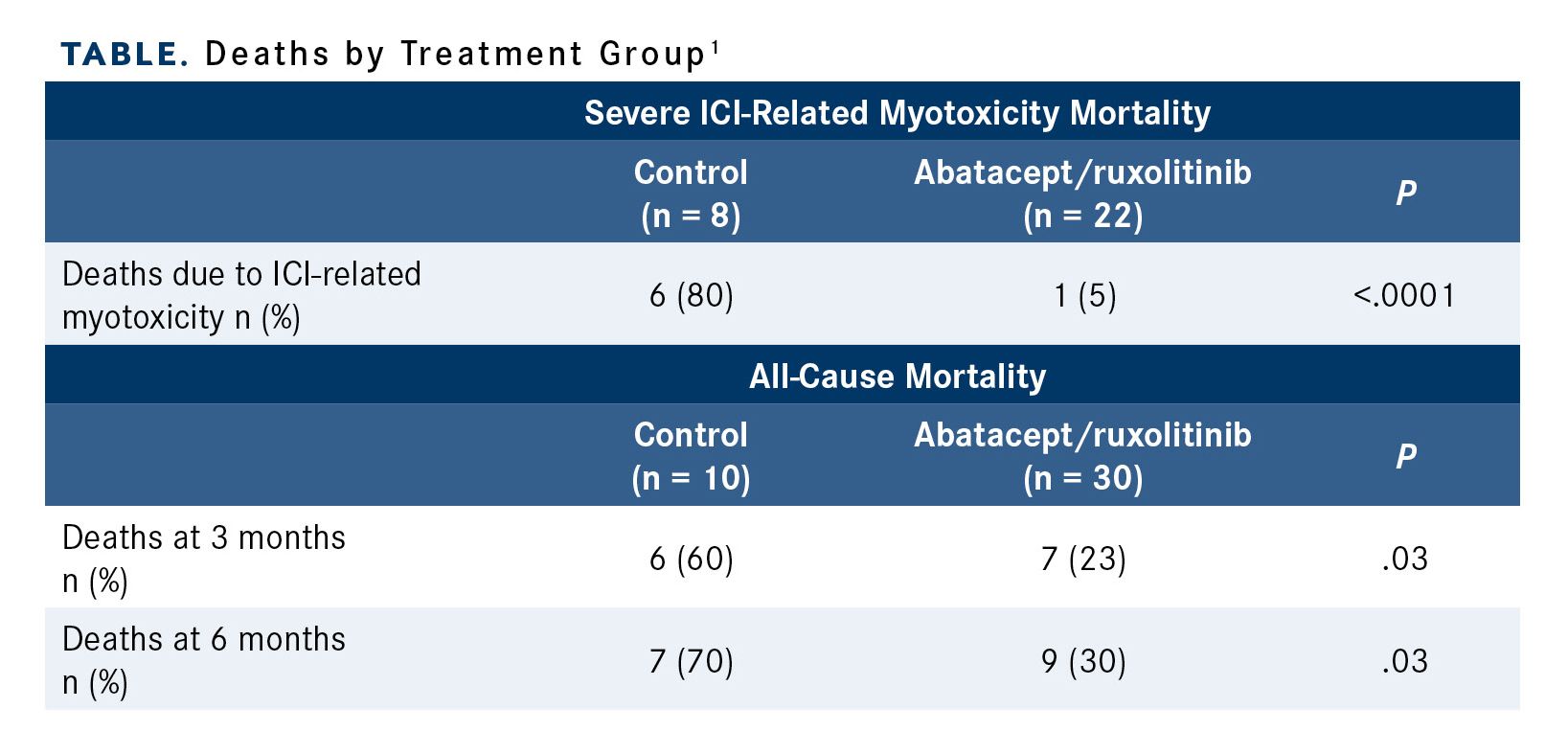Article
Abatacept/Ruxolitinib May Reduce Cardiotoxicity Associated With Immune Checkpoint Inhibitors
Author(s):
French investigators evaluated a potential solution to reduce myotoxicity and improve survival for patients with cancer receiving treatment with immune checkpoint inhibitors.
Joe-Elie Salem, MD, PhD

French investigators evaluated a potential solution to reduce myotoxicity and improve survival for patients with cancer receiving treatment with immune checkpoint inhibitors (ICIs). Their strategy of combining abatacept (Orencia) and ruxolitinib (Jakafi) with mechanical ventilation reduced myotoxicity‐related fatality by 94.3% (P <.0001), in newly published results published in Cancer Discovery.1
The experimental approach included prompt use of high-dose abatacept with real‐time CD86 receptor occupancy monitoring, ruxolitinib, lower doses of corticosteroids, and systematic screening for and early management of concomitant respiratory muscle failure.
Sixty percent (n = 6/10) of patients who received the current standard of care died due to ICI-related myotoxicity. In contrast, just 1 of 30 (3.3%) patients died due to ICI-related myotoxicity in the experimental arm. Among patients with grade 3 or higher myotoxicity, 6 of 8 (80%) patients in the control group died compared with 1 of 22 (5%) in the experimental arm (TABLE).

Lead author Joe-Elie Salem, MD, PhD, a professor at Sorbonne Université and executive assistant director of one of France’s Clinical Investigation Centers focused on cardio-metabolism, cautioned against making too much of the results because this study was not a clinical trial. Nonetheless, he called the findings “fascinating” in an interview with OncLive®.
“The results are pretty unique, because basically, we were being sent patients [who were] almost dead from all of the centers in France. We were kind of the last resort unit to treat those patients,” he said. “It was very incredible to see those patients who were extremely sick be able to get out from the hospital. For me, it was really fascinating.”
Treatment with ICIs is often concurrent with myocarditis and myositis, and can be highly fatal. ICI-related myocarditis is rare but has a mortality rate upwards of 60%. Current treatment options include empiric corticosteroids, which are not universally effective, and second-line therapies such as immunosuppressive therapies targeting T cells. Salem et al devised a strategy that included screening for respiratory muscle involvement in patients with severe ICI‐related myocarditis, then administering abatacept and ruxolitinib.
Abatacept, approved for the treatment of patients with rheumatoid arthritis, prevents macrophages from activating T cells and is sometimes used at low doses to help treat ICI-related myocarditis. Ruxolitinib inhibits the immune-stimulatory proteins JAK1 and JAK2, thereby also decreasing T-cell activation.
Salem said that abatacept acts as a kind of “antidote” to the pathways activated by ICIs. “The problem is that it takes time—a few days to a week to be fully active, which is not the time we have in this complication. We had to combine it with another drug, which is ruxolitinib, to be synergistic in terms of pharmacology, acting on both the 2 types of cells that are involved in toxicity: macrophages and T cells.”
Data from previous studies have shown that abatacept may address myocarditis, but the optional dosing has not been defined. Furthermore, the effect of combining the CTLA-4 immunoglobulinfusion‐protein with other immunosuppressants is also unknown.
Investigators included findings from 40 patients in these data. The first 10 received high dose corticosteroids boluses followed by second-line agents in case of cortico‐resistance, in keeping with the current expert consensus guidelines. The remaining 30 were treated with the abatacept/ ruxolitinib/ mechanical ventilation protocol.
The median patient age was 70 years (interquartile range, 62-79) and 58% of patients were male. Genitourinary cancers (25%) were the most common malignancies followed by lung cancer and skin cancer (23% each).
The overall clinical demographic and diagnostic characteristics of the 2 cohorts were similar with no difference in peak cardiac troponin‐T reached or in the different myotoxicity severity features studied (arrhythmia, cardiac and respiratory muscle dysfunction) upon presentation or during follow‐up. Thirty patients (75%) developed grade 3 or higher myotoxicity. All patients had increased troponin‐T. Eighty-five percent developed abnormal ECG features and 9 (23%) developed grade 3 or higher systolic cardiac dysfunction. Five (13%) required inotropic agents or extracorporeal hemodynamic support.
Five patients died before cMRI or refused the scan. Eight died prior to cardiac biopsy or refused it.
When investigators screened for respiratory muscle failure, they found that 30% of the experimental cohort was eligible for elective ventilation. One patient declined intubation, which was the only patient death in that cohort. One patient with hepatic cancer died of decompensated cirrhosis before starting ventilation.
Six of the 8 remaining ventilated patients had complete recovery (median weaning time, 17 days). Two were weaned from diurnal ventilation and were on residual nocturnal ventilation at the 6-month follow‐up.
The overall survival (OS) rate was 40% at 3 months posttreatment and 20% at 6 months in the control group.2 For patients in the experimental group, the OS rate was 77% and 70%, respectively.
Salem noted that myotoxicity is rare, but he expects incidence to increase as ICIs become more common. He’s seen the pattern in his own research. Enrollment in the trial was slow in 2018 and 2019, then increased dramatically starting in 2020 along with growth in the use of ICIs.
Salem said investigators initiated the phase 2 ACHLYS trial (NCT05195645) in December 2022 to evaluate the optimal dose of abatacept in patients with ICI-related myotoxicity. Investigators have recruited 3 patients so far.3
References
- Salem J-E, Bretagne M, Abbar B, et al. Abatacept/ruxolitinib and screening for concomitant respiratory muscle failure to mitigate fatality of immune‐checkpoint inhibitor myocarditis. Cancer Discov. Published online February 23, 2023.
- New treatment regimen may decrease mortality in patients with cardiotoxicity from immune checkpoint inhibitors. American Association for Cancer Research. February 23, 2023. Accessed February 23, 2023. https://www.eurekalert.org/news-releases/980264
- AbataCept for the treatment of immune-checkpoint Inhibitors induced myocarditis (ACHLYS). ClinicalTrials.gov. Accessed February 22, 2023. https://clinicaltrials.gov






